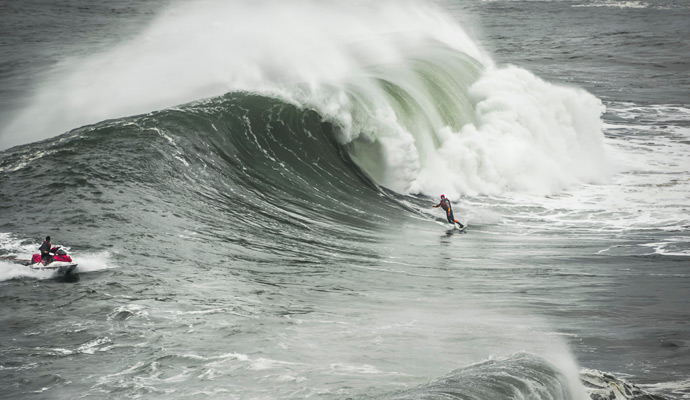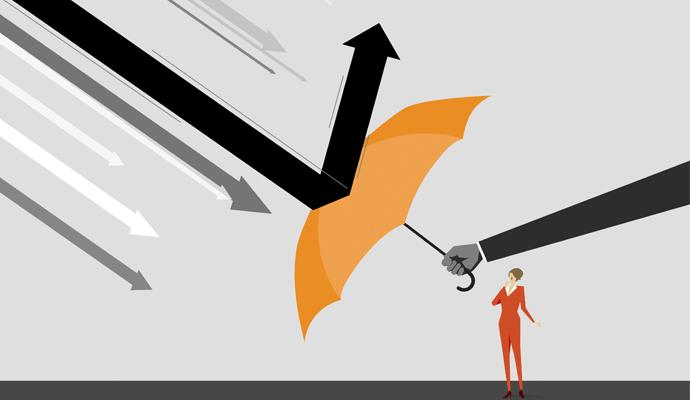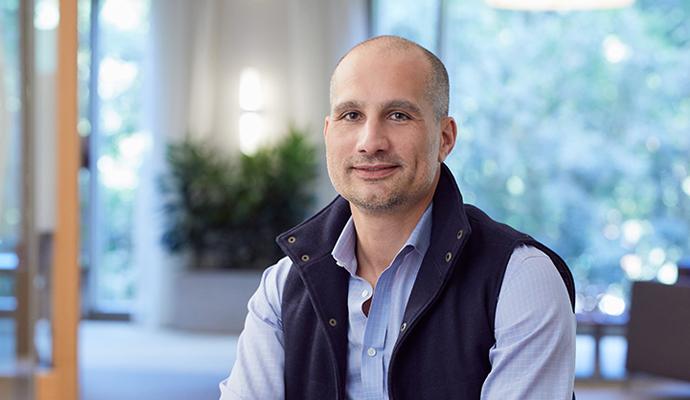Why big-wave surfers are just like actuaries
In her new book, Allison Schrager argues that we can learn a lot about risk management, moral hazard, and financial safety from the dudes who tackle 80-foot waves on fiberglass boards.
In many ways the Big Wave Risk Assessment Group (BWRAG) Safety Summit on the North Shore of Oahu was different from other risk conferences I’ve attended. Risk conferences are usually my domain (I am a retirement economist, after all). Everyone (but me) was tan and in excellent physical shape. Most wore shorts, T‑shirts, and flip-flops. The day included workshops on holding your breath led by deep-sea divers. Former Special Forces officers instructed us on how to tie a tourniquet and perform an emergency tracheotomy with a pen. At one point, someone used the word gnarly, but as a technical term. I even renewed my CPR certification.
But in other ways, the big-wave safety summit was just like a pension risk conference: Most of the attendees were men; a majority of the time was spent looking at PowerPoint slides of numbers and figures; and there were impassioned debates about who bears responsibility for risk regulation. Surfers also shared the latest tools on how to minimize risk and discussed techniques on how to turn uncertainty into risk by estimating probabilities. And, like the financial specialists at pension conferences, the professional reputation of the people here depended on using risk management techniques, even though those same tools also expose them to bigger risks. In many ways, big-wave surfers are just like actuaries, except with better skin tone.
The goal of the BWRAG conference is to apply risk science to big-wave surfing. Instead of going into the ocean and hoping for the best, surfers are schooled in the “art” of risk: how to form calculated, informed risk assessments. Although the risk mitigation tools appear to be different from those used in financial markets, they serve a similar purpose. Surfers form well-trained teams to raise the odds of a successful rescue (diversification). They monitor wave conditions, identify hazards (sharks, crowds, rocks, deep water, cold), and make probability estimates on the odds things will go wrong. This is so the surfers can make informed trade-offs about the thrill of riding a big wave safely (hedging). And they use the latest technology to rescue them when they wipe out (insurance).
Some of the techniques are low-tech and commonsense. For example, waves tend to travel in packs, or sets. If you know the surfable waves in front of you are part of a five-wave set, a hedging strategy is taking the fourth wave, even if the first one is bigger. That way after you finish, or wipe out, you aren’t pounded or held underwater by the next big waves in the set.
The big-wave safety summit started after the famed surfer Sion Milosky drowned in 2011 off the coast of Northern California. Surfers decided there needed to be more safety and training mechanisms in place and best practices established to reduce risk. BWRAG brings surfers together to make safety a priority and learn about the latest risk technology.
Risk awareness is more critical than before as technology continues to transform big-wave surfing. A sport of a few men riding 20‑ to 30‑foot waves has morphed into a scientific endeavor, supported by the latest gadgets, to surf 50‑, even 80‑foot waves. When used correctly, technology augments but does not replace skill. The problem is many surfers use technology to make up for deficient swimming and surfing abilities.
Jet skis to the rescue
Brian Keaulana is one of the founders of BWRAG. He is to big-wave surfing what the Nobel Prize–winning economist Robert C. Merton is to finance. Merton enabled the widespread use of options in financial markets, which empowered people to take risks in markets by having insurance against downside. Keaulana introduced jet skis to big-wave surfing; these invaluable tools are used to rescue surfers who wipe out.
Jet skis can cut through rough waters so an injured surfer can be brought to shore quickly to receive medical attention. They are effectively insurance: providing protection if things go wrong, while still offering the unlimited upside of surfing big waves.
Keaulana is in his mid-50s, a lifelong Hawaiian big-wave surfer, former lifeguard, and now noted stuntman. He played himself in an episode of Baywatch. Keaulana speaks proudly of Hawaiian values of knowing and respecting the water. He marries his spirituality and reverence for tradition with a love of technology and a fierce interest in modern risk strategy. He proudly showed off his latest Apple Watch and explained that it is waterproof so he can make phone calls when he is in the ocean to coordinate a rescue.
Just like Merton, Keaulana was profoundly influenced by his father, Richard “Buffalo” Keaulana, a big-wave surfing legend.
Nearly 4,000 miles of unobstructed ocean off the coast of Japan end at Oahu’s North Shore, producing some of the world’s largest waves. When surfers started coming to Hawaii to ride the North Shore’s big waves in the 1950s, Buffalo was a lifeguard. It was the golden age of big-wave surfing, and Buffalo made his mark on the sport. In a watershed moment for big-wave surfing, his longtime partner Greg Noll rode a storied 35‑foot wave in 1969, the largest wave anyone had surfed at that time. Buffalo raised his children in the water and now, in his mid-80s, is the patriarch of a big-wave surfing dynasty. He stopped surfing only a few years ago. “Surfing is the fountain of youth,” Brian explains.
In the late 1980s, Brian Keaulana was a contestant in one of the largest big-wave surfing competitions, the Eddie (named after the surfer Eddie Aikau), on Waimea Bay. He wiped out in rough water. As Keaulana swam, he thought about a surfer who had recently wiped out and drowned while he was the lifeguard on duty. He couldn’t get to the surfer in time because of the turbulent ocean. Now Keaulana found himself in similar conditions, and as he rode out the rough surf, his friend Squiddy came by in a stand‑up jet ski and asked if he was OK. Squiddy couldn’t rescue him on a stand‑up ski, but a “light went on” for Keaulana. Jet skis would allow him to reach surfers in much rougher conditions, and he could save more people.
Yamaha had recently released the WaveRunner, a sit-down ski that could make rescues in treacherous waters possible. Keaulana took out a loan, bought one, and started experimenting. After some trial and error, he attached a boogie board to the back as an early rescue sled and started using jet skis in rescues.
A few years later, Keaulana and another lifeguard used jet skis to save seven surfers swept out to sea. When Keaulana returned to the beach, he got a ticket for improper use of a jet ski, which was licensed only for recreation at the time. Keaulana successfully fought the ticket and started lobbying local politicians to change the law, explaining how jet skis could make ocean rescues safer.
The law was changed, and Keaulana helped set up standards and training for using jet skis in water rescues. Today it’s normal to see a jet ski parked in the water when surfers tackle big waves. Keaulana smiles as he remembers the first time he brought a jet ski to a major surfing competition. The surfers even stopped the contest while Keaulana ate lunch because they wouldn’t surf unless he was nearby on his jet ski.
Soon after Keaulana introduced jet skis, big-wave surfers like the legendary Laird Hamilton started using them to take the sport to new heights. Hamilton and his friends began using jet skis to launch themselves onto big waves no human could reach by paddling. Called tow‑in surfing, this technique makes it possible to ride 70‑ or 80‑foot waves.
Keaulana has done some tow‑in surfing himself and doesn’t seem bothered by how jet skis have changed the sport. But he worries that people are using them as a crutch to surf waves beyond their skill level: “It gets abused. Maybe people should be out there in 10-foot water, not 20. They are counting on jet skis to save them and are out there for the wrong reasons — to get noticed, for practice. They count on skis and lifeguards to rescue them. One guy [in large surf] says to me, ‘Keep an eye on me, I am not that good.’”
In 1975, University of Chicago economist Sam Peltzman observed that improving car safety caused more accidents because people took more risks when driving. With power steering, antilock brakes, widespread use of seat belts, and driver-assist alerts if we are too close to another vehicle or pedestrian, cars are safer than ever, but we also drive faster. Taking a bigger risk because technology imparts a feeling of safety is known as the Peltzman effect.
We often fear technology because it means change, but the real downside it poses is that we end up taking even bigger risks because it makes us feel safer.
The challenge facing surfers, financiers, and the rest of us is how to avoid the Peltzman effect and use technology in a less risky way, even as it offers the promise of more thrilling opportunities.
80-foot financial waves
Jet skis in big-wave surfing serve the same purpose stock options do in financial markets. Both act as a way to insure against downside risk and still leave unlimited upside. But both can be used to assume even bigger risks, taking on more leverage to amplify returns or to surf 80‑foot waves. Sometimes, even for those with the best training and years of experience, that risk goes horribly wrong. Malik Joyeux, Sion Milosky, and Kirk Passmore are among the accomplished big-wave surfers who have died within the past two decades. We have seen the same dynamic in finance.
Jet skis in big-wave surfing serve the same purpose stock options do in financial markets. Both act as a way to insure against downside risk and still leave unlimited upside.
Robert C. Merton and Myron Scholes, whose Black–Scholes formula facilitated the growth of the options market, were partners at Long-Term Capital Management (LTCM), a hedge fund that took on too much risk and nearly caused a financial crisis. The fund, founded in 1994, had the best collection of industry and academic stars on the market. Its primary strategy was to profit off small differences in prices between two bonds with almost the same maturity. The fund used large amounts of debt to amplify the risk and the expected return. LTCM enjoyed great success. By the start of 1998, LTCM had about US$4.8 billion in equity capital and had borrowed over $124.5 billion, a 25‑to‑one leverage ratio.
A few months later Russia devalued its currency and defaulted on its debt. This was followed in short order by the Asian financial crisis. LTCM used risk tools — diversification, hedging, and insurance — to reduce the risk associated with its leverage. But the fund quickly discovered the tools’ limitations as larger waves swamped the financial markets. Assets that were supposed to offer a hedge suddenly did not. LTCM lost money in 1998: Within eight months $4.8 billion dwindled to only $2.3 billion. At this rate, LTCM couldn’t pay back the money it owed. The damage from a situation like the one LTCM faced would usually be limited to the investors and partners in the fund. But the risk in this case went beyond LTCM. A large part of its business consisted of acting as an intermediary between different banks that wanted bonds with different maturities. LTCM was a very large player in the market, so most of the large banks would be stuck with bonds they did not want and could not sell if LTCM defaulted.
The Federal Reserve Bank of New York brokered a deal, and 14 financial firms pooled $3.6 billion for a 90 percent stake in LTCM. This capital injection stopped the bleeding: Debts were repaid, markets calmed down, and eventually LTCM was unwound. In the end, the partners and their few remaining investors lost all the money they had put in and earned at the fund. The banks who bought the 90 percent equity share made money and the market remained stable. It was a near miss.
What went on at LTCM has often been held up as a failure of complex risk models. But what went wrong is much simpler. Basically, the fund took on too much risk seeking higher returns. But risk models can’t account for everything that can possibly happen, and they are not meant to. A 25‑to‑one leverage ratio is the equivalent of surfing an 80‑foot wave. You can do all your research, bring jet skis, and wear an inflatable vest, but oceans and financial markets aren’t always predictable. There is no way to make an 80‑foot wave safe and there is no way to make a 25‑to‑one leverage ratio risk-free.
The golden age wasn’t so golden
It wasn’t always so complicated. In the 1950s and 1960s, investors in financial markets were limited to the few people who could afford to lose money, and millions of complicated derivatives weren’t used to hedge risk. In Buffalo Keaulana’s youth, there were only a few dozen big-wave surfers, and they didn’t even have a leash to tether them to their long boards (this important safety innovation was introduced in the 1970s). When surfers wiped out and lost their boards, they might have to swim more than a dozen miles to find a safe place to go ashore. In that era, big-wave surfers were all exceptional swimmers and knowledgeable about the ocean. Today almost all surfers have a leash on their boards. When leashes were first introduced, they made surfing more accessible to weaker swimmers. From the moment they were introduced, leashes were controversial and divisive in the surfing community because they meant less-skilled surfers in the water.
Melvin “Uncle Mel” Pu’u is another surfer at the forefront of risk technology. A large, round, bald man who is father to eight children, he was orphaned at a young age and taken in by the Keaulana family. Uncle Mel and Brian Keaulana grew up as brothers, surfing and lifeguarding, and are so close they finish each other’s sentences.
Uncle Mel, Keaulana, and I took a break from the big-wave safety summit and had a lively discussion about the Peltzman effect, or what they call the “double-edged sword of safety.” I asked if surfing would be better without all the technology, if we could go back to a simpler time when only surfers with excellent training and superhuman swimming skills like Buffalo were in the water. No waterproof Apple Watches, jet skis, inflatable vests, or surfers who don’t belong. “My answer would be no,” Uncle Mel said. “We’d have more deaths. The surfing industry has grown to a level and scale not seen in the early 1950s. Now there’s so much exposure and there’s more opportunity. When you have this opportunity and equipment, you are going to have people pushing the limits — it just comes with a double-edged sword. There will be those who shouldn’t be out there, taking advantage of the technology at hand…. It becomes an issue of maybe it would be better if we didn’t [have all the safety tools], but it becomes a necessity that we do.”
“It also helped us understand our mind and our physical limits,” Keaulana added. “Because we could never test our limits without the use of technology. No one surfed North Shore before. Mostly military people came here, they died, then [we got] better boards [and thought], oh, we can surf this. Then the jet ski came and we went to the outer reefs. It raised the level of what our minds and bodies can do out in the environment with proper use of technology, but it takes the right people with the right equipment.”
People often ask the same question about financial markets. The logic goes that the world would be better off if the financial derivatives that came from Black–Scholes disappeared and we returned to smaller, simpler financial markets. But just as the intent of using jet skis and inflatable vests is to offer safety to surfers who want to pursue bigger waves, the intent of most financial innovation is to find ways to offer investors security while they still enjoy some upside from taking risk.
In both surfing and finance, better insurance means more opportunity and growth. Financial innovation promises to offer cheaper and less-risky ways to finance new technology. As technology evolves, so do the tools that finance it. New innovations in finance that made it possible to manage risk can explain everything from the rise of ancient Rome to the growth of modern cities. The evolution of finance since the 1970s powered more risk taking, which has meant more wealth flowing to poor countries, more development, and less global poverty. In richer countries, financial innovation has enabled advances we enjoy today. A more global, integrated economy requires financial tools that did not exist in the 1950s and 1960s.
Sometimes risks don’t work out, but this is the price we pay for a growing economy and more prosperity. The trick is to find ways to limit the collateral damage from risks gone wrong.
How can we do better?
The fact that any risk innovation empowers us to take more risk is exactly why routinely updating regulations is necessary, whether in financial markets or surfing. What Brian Keaulana did should be a model of how we, and regulators especially, should approach safety innovations. First he changed the rules for jet skis when he discovered they were a useful safety device. Then he focused on education so people would use the tools responsibly. Now the state of Hawaii requires certification to use jet skis for tow‑in surfing.
Most of us aren’t lucky enough to know someone like Keaulana who can provide the intellectual leadership an industry needs. Regulations such as speed limits on highways and capital ratios for banks can curb some of our worst impulses to take on more risk. But as long as we constantly innovate new ways to reduce risk and thereby create an opportunity to take more risks, regulation will struggle to keep pace.
It ultimately falls on us to be mindful of the risks we take. The modern world offers you the chance to take bigger risks than you should, such as surfing a 50‑foot wave when you barely know how to swim or using a financial derivative to take on tons of leverage to bet on a stock. Each of these options offers the chance for huge rewards, but it is worth asking if that reward is really your goal, and if it is worth swimming in dangerous waters to get it.
Author profile:
- Allison Schrager is an economist, a journalist at Quartz, and cofounder of LifeCycle Finance Partners LLC, a risk advisory firm.
- From An Economist Walks Into a Brothel: And Other Unexpected Places to Understand Risk, by Allison Schrager, to be published on April 2, 2019, by Portfolio, an imprint of Penguin Publishing Group, a division of Penguin Random House LLC. Copyright © 2019 by Allison Schrager.






